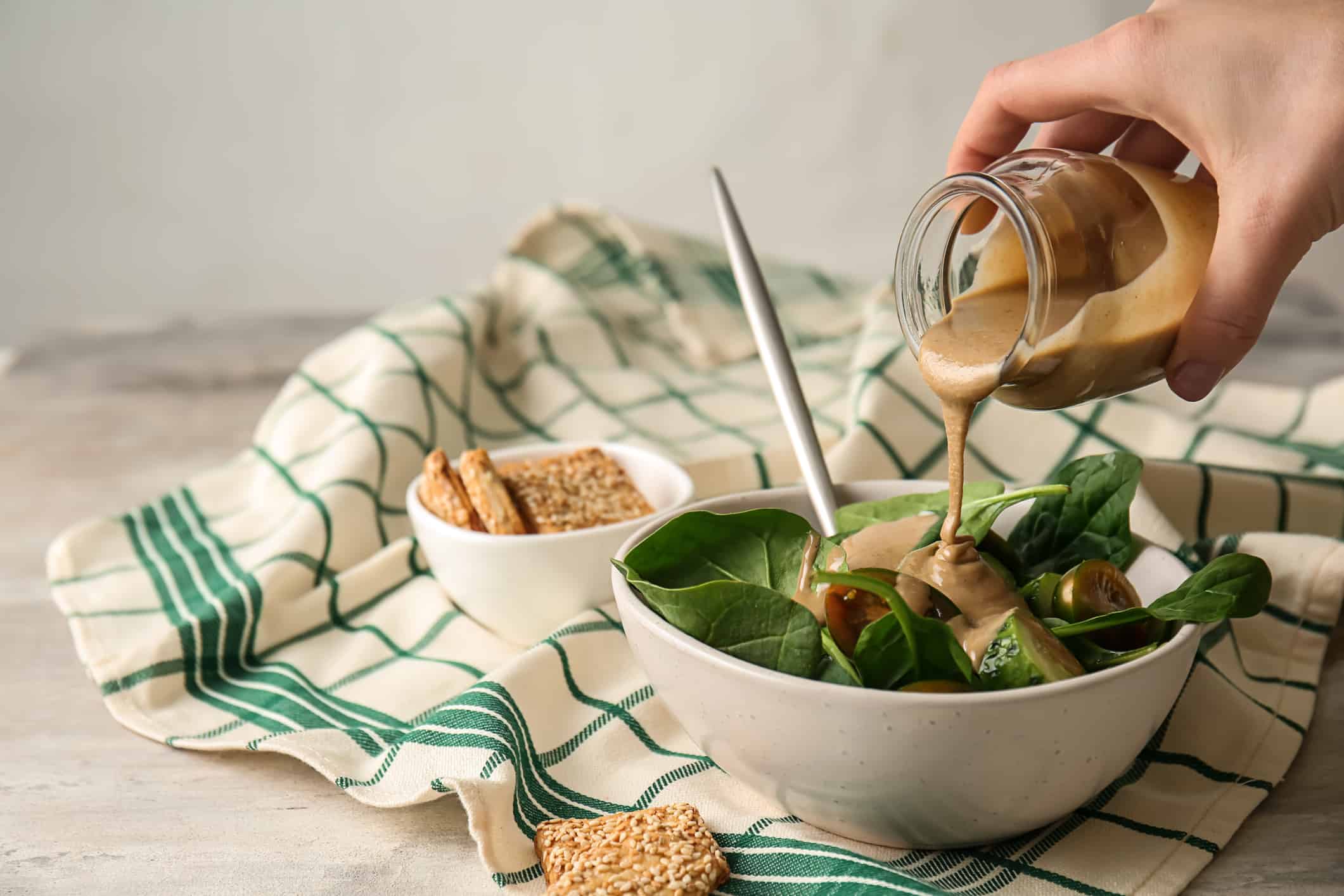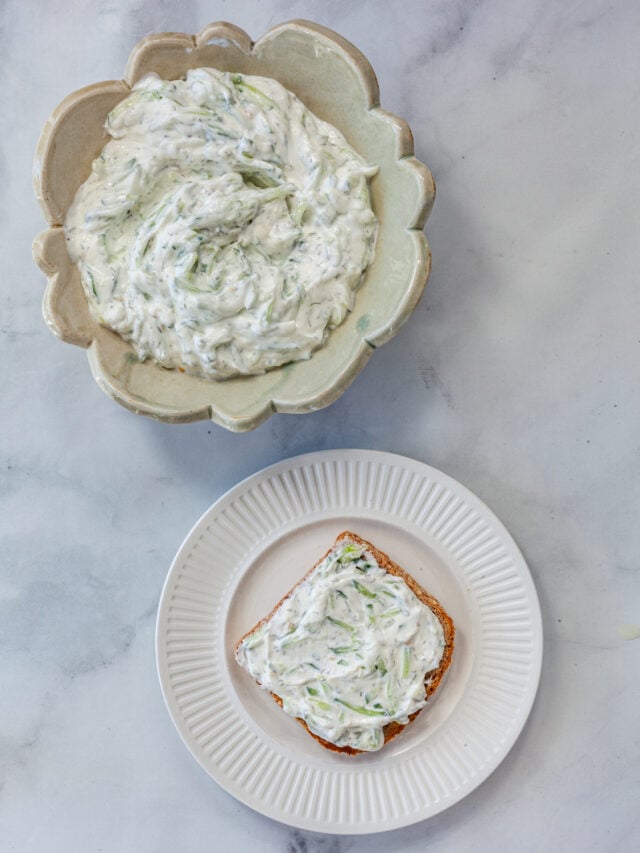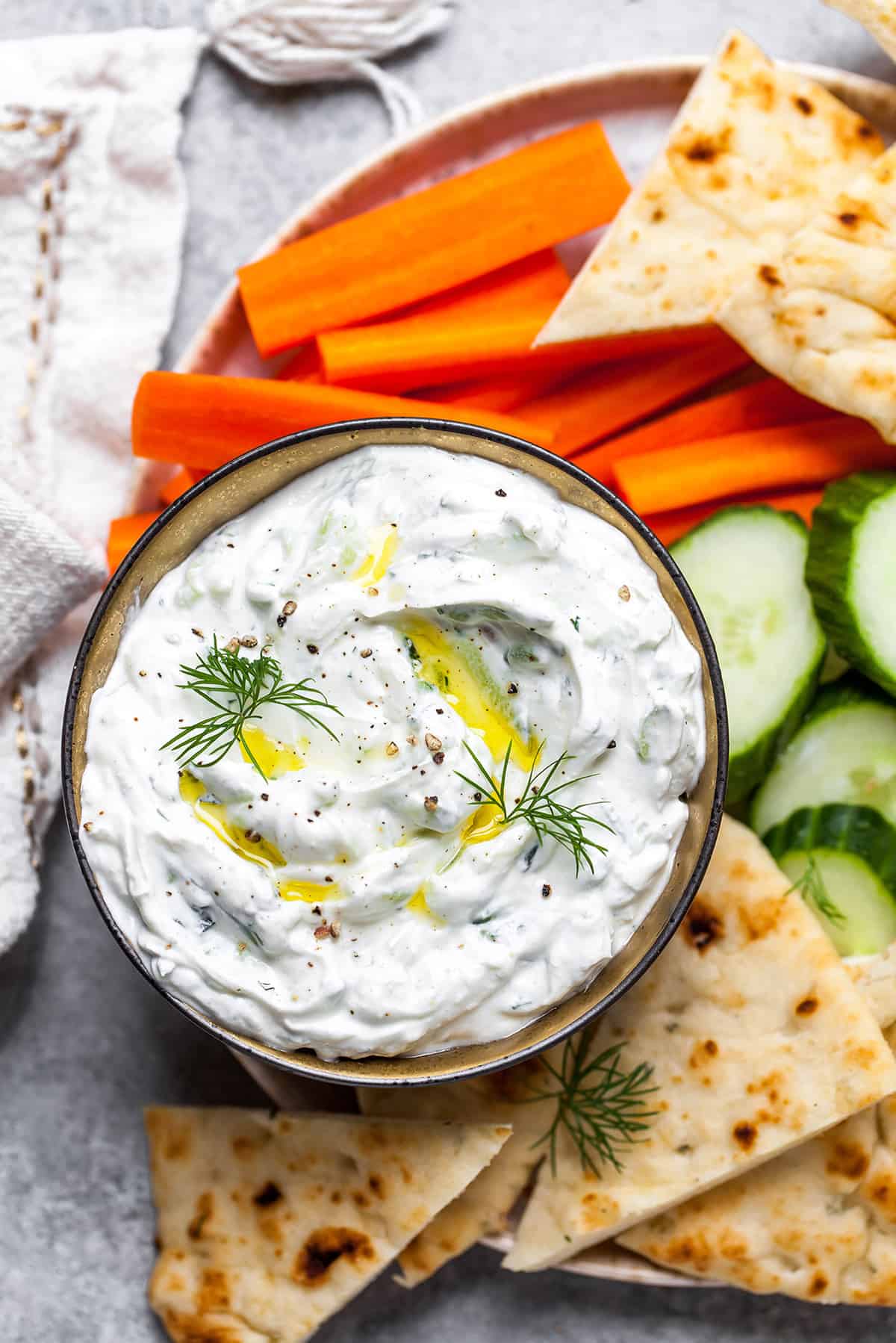Introduction

Tzatziki and tahini are two contrasting Mediterranean condiments that add flavor and texture to a variety of dishes. While tzatziki is a refreshing and creamy yogurt-based dip with hints of cucumber, tahini is a rich and nutty paste made from sesame seeds. These condiments have a long history and cultural significance in Mediterranean and Middle Eastern cuisine. Understanding their distinct ingredients, nutritional value, and flavor profiles allows for a better appreciation of their diverse uses in cooking. Whether you’re a fan of the tangy and herbaceous tzatziki or the bold and earthy tahini, both condiments have their unique place on the culinary scene.
Brief Overview Of Tzatziki And Tahini
Tzatziki and tahini are both popular Mediterranean condiments that bring unique flavors to dishes. Tzatziki is a creamy and tangy dip made from yogurt, cucumber, garlic, and herbs like dill or mint. It offers a refreshing and cooling effect, making it a perfect accompaniment to grilled meats or as a dip for vegetables or pita bread. On the other hand, tahini is a paste made from ground sesame seeds. It has a rich, nutty flavor and a creamy consistency. Tahini is often used as a sauce or dressing for various dishes like falafel or as an ingredient in hummus.
History And Cultural Significance
Tzatziki and tahini both have rich histories and cultural significance in Mediterranean cuisine. Tzatziki originated in Greece and is a staple in Greek cuisine. It has been enjoyed for centuries and is often served with grilled meats, as a dip for vegetables or pita bread, or as a sauce for gyros. On the other hand, tahini has its roots in Middle Eastern and North African cuisines. It is an essential ingredient in dishes like hummus and falafel. Tahini holds cultural importance in these regions and is considered a versatile and nutritious addition to many dishes.
Ingredients And Nutritional Value

Tzatziki is made with Greek yogurt, cucumber, garlic, lemon juice, and fresh herbs like dill and mint. This creamy dip is low in calories and fat, but high in protein and calcium. It also provides a good amount of Vitamin C and potassium.
Tahini is made from ground sesame seeds and has a rich, creamy texture. It is packed with healthy fats, protein, and fiber. Tahini is also a good source of vitamins and minerals, including iron, magnesium, and phosphorus.
Both tzatziki and tahini offer nutritional benefits and can be a wholesome addition to meals. However, it is important to consume them in moderation due to their calorie and fat content.
Tzatziki Ingredients And Nutrition
Tzatziki is made with a combination of Greek yogurt, cucumber, garlic, lemon juice, and fresh herbs like dill and mint. These ingredients come together to create a refreshing and tangy dip. In terms of nutrition, tzatziki is low in calories and fat, making it a healthier option for dipping sauces. It is also high in protein and calcium, providing essential nutrients for a balanced diet. Additionally, tzatziki contains a good amount of Vitamin C and potassium, which are important for immune function and maintaining electrolyte balance.
Tahini Ingredients And Nutrition
Tahini is made from ground sesame seeds, which gives it a creamy and nutty flavor. It is a versatile ingredient used in many Mediterranean and Middle Eastern dishes. In terms of nutrition, tahini is packed with essential nutrients. It is a good source of protein, fiber, and healthy fats. Tahini also contains important minerals such as calcium, iron, and magnesium. Additionally, it is rich in antioxidants and vitamins, including vitamin E. Incorporating tahini into your diet can provide various health benefits and add depth of flavor to your meals.
Flavor Profile And Culinary Uses

Tzatziki: Tzatziki has a cool and refreshing flavor profile with a tangy taste. The combination of Greek yogurt, cucumber, garlic, and dill gives it a creamy and herbaceous taste. Tzatziki is commonly used as a dip for grilled meats, a sauce for gyros and falafels, and a spread for sandwiches and wraps. It adds a burst of freshness to dishes and complements the flavors of Mediterranean cuisine.
Tahini: Tahini has a rich and nutty flavor profile with a hint of bitterness. It adds depth and complexity to dishes. Tahini is used as a key ingredient in Middle Eastern spreads like hummus and baba ganoush. It is also used as a dressing for salads, a sauce for roasted vegetables, and a base for marinades and dressings. Tahini enhances the taste of dishes and lends them a rich and creamy texture.
Tzatziki Flavor Profile And Pairing
Tzatziki has a cool and refreshing flavor profile with a tangy taste. The combination of Greek yogurt, cucumber, garlic, and dill gives it a creamy and herbaceous taste. Tzatziki is commonly used as a dip for grilled meats, a sauce for gyros and falafels, and a spread for sandwiches and wraps. It adds a burst of freshness to dishes and complements the flavors of Mediterranean cuisine. Tzatziki pairs well with dishes like grilled lamb, roasted vegetables, pita bread, and salad. Its creamy texture and tangy flavor make it a versatile condiment that can enhance various dishes.
Tahini Flavor Profile And Culinary Applications
Tahini has a distinctive flavor profile that is rich, nutty, and slightly bitter. Made from ground sesame seeds, it adds a deep and earthy taste to dishes. Tahini is a versatile ingredient used in both sweet and savory recipes. It is commonly used to make tahini sauce, which is a popular dressing for salads, falafels, and grilled meats. Tahini is also used in dips like hummus and baba ganoush, adding a creamy and nutty element to these dishes. It can even be incorporated into desserts, such as tahini cookies or halva. The possibilities are endless with tahini.
Health Benefits And Allergies

Tzatziki and tahini both offer several health benefits. Tzatziki, made with Greek yogurt, is an excellent source of protein and calcium. It also contains probiotics, which promote healthy digestion and a strong immune system. On the other hand, tahini is a good source of healthy fats, vitamins, and minerals, including iron and magnesium. It also provides dietary fiber and antioxidants. However, it’s important to note that both condiments can be allergenic. Tzatziki may cause issues for individuals with lactose intolerance or dairy allergies. Tahini can pose a risk for those with sesame allergies, which can cause allergic reactions ranging from mild to severe. It’s essential to be aware of any allergies or intolerances before consuming these condiments.
Tzatziki Health Benefits And Allergies
Tzatziki, made with Greek yogurt, offers several health benefits. It is an excellent source of protein and calcium, which helps support bone health. The probiotics in tzatziki promote a healthy digestive system and strengthen the immune system. Additionally, tzatziki is low in calories and fat, making it a healthier alternative to other creamy dressings and sauces. However, it’s important to note that tzatziki may cause issues for individuals with lactose intolerance or dairy allergies. It is important to be aware of any allergies or intolerances before consuming tzatziki.
Tahini Health Benefits And Allergies
Tahini offers several health benefits. It is rich in healthy fats, including omega-3 and omega-6 fatty acids, which are beneficial for heart health. Tahini is also a good source of essential minerals like calcium, iron, and magnesium. These minerals support bone health, blood circulation, and muscle function. Additionally, tahini contains antioxidants that help reduce inflammation in the body. However, individuals with sesame seed allergies should avoid tahini, as it is made from ground sesame seeds. It’s important to be aware of any allergies or intolerances before consuming tahini.
Cooking Tips And Serving Suggestions

To enhance the flavors of tzatziki and tahini, here are some cooking tips and serving suggestions:
- Tzatziki:
- Use Greek yogurt for a thick and creamy tzatziki.
- Squeeze out excess water from the cucumber to avoid a watery consistency.
- Serve tzatziki as a dip with pita bread or vegetables.
- Use tzatziki as a refreshing sauce for gyros, kebabs, or grilled meats.
- Spread tzatziki on sandwiches or burgers for a tangy twist.
- Tahini:
- Stir tahini well before using as the oil can separate.
- Mix tahini with lemon juice or garlic for added flavor.
- Drizzle tahini on roasted vegetables or salads for a creamy dressing.
- Use tahini as a base for hummus or as a spread on toast.
- Incorporate tahini into baking recipes for a nutty taste.
Remember to refrigerate these condiments for freshness, and enjoy their unique flavors in various Mediterranean-inspired dishes.
How To Make Tzatziki At Home
To make tzatziki at home, start by peeling and grating a cucumber. Squeeze out any excess water from the cucumber to prevent a watery consistency in the tzatziki. In a bowl, combine the grated cucumber, Greek yogurt, minced garlic, chopped dill, lemon juice, and a drizzle of olive oil. Season with salt and pepper to taste. Mix everything together until well combined. Cover and refrigerate for at least 1 hour to allow the flavors to meld together. Serve tzatziki as a dip with pita bread or veggies, or use it as a sauce for gyros or grilled meats. Enjoy this refreshing and tangy condiment with your favorite Mediterranean dishes.
Creative Ways To Use Tahini In Recipes
Tahini is not just limited to being a dip or a sauce. Its rich and creamy texture makes it a versatile ingredient that can be used in a variety of recipes. Here are some creative ways to incorporate tahini in your cooking:
- Dressings and Sauces: Make a flavorful salad dressing or sauce by combining tahini with lemon juice, garlic, and olive oil. It adds a delicious creamy element to any salad or roasted vegetables.
- Baked Goods: Add tahini to your cookie or brownie batter for an extra nutty flavor. It also works well in bread recipes, giving them a unique taste and a soft texture.
- Smoothies and Shakes: Include a spoonful of tahini in your morning smoothie or milkshake for a boost of protein and a creamy consistency.
- Marinades and Glazes: Use tahini as a base for marinades and glazes for grilled meats or roasted vegetables. Its nutty flavor adds depth and richness to the dish.
- Desserts: Get creative with desserts by incorporating tahini into recipes like cheesecakes, ice cream, or even fudge. It adds a unique twist to traditional sweet treats.
By thinking outside the box, you can explore the full potential of tahini and elevate your dishes with its rich and nutty flavor. Give these creative ideas a try and enjoy the versatility of tahini in your cooking.
Conclusion

In conclusion, while tahini and tzatziki are both popular condiments in Mediterranean cuisine, they have distinct differences in terms of ingredients, flavors, and culinary uses. Tahini, made from ground sesame seeds, offers a rich and nutty flavor, while tzatziki, made primarily with yogurt and cucumber, provides a cool and tangy taste. Both condiments offer unique culinary opportunities, whether it’s using tahini to add richness to dressings and baked goods or enjoying tzatziki as a refreshing dip or sauce. These contrasting condiments enhance the flavor and diversity of Mediterranean dishes, making them a must-try in any culinary exploration.
Comparison Between Tzatziki And Tahini
When comparing tzatziki and tahini, there are several key differences to consider.
- Ingredients: Tzatziki is primarily made with yogurt, cucumber, garlic, and herbs, giving it a cool and tangy flavor. On the other hand, tahini is made from ground sesame seeds, resulting in a rich and nutty taste.
- Culinary Uses: Tzatziki is commonly used as a refreshing dip, sauce, or dressing for dishes like gyros, kebabs, and salads. Tahini, on the other hand, is a versatile condiment used in Middle Eastern cuisine for dishes like hummus, falafel, and tahini sauce.
- Texture: Tzatziki has a creamy and smooth texture, while tahini has a thicker and more spreadable consistency.
In summary, while both tzatziki and tahini are delicious Mediterranean condiments, they differ in ingredients, flavor profiles, and culinary applications, allowing for diverse and unique dining experiences.
Popular Dishes Incorporating Tzatziki And Tahini In Mediterranean Cuisine
Tzatziki and tahini are widely used in Mediterranean cuisine and can be found in a variety of popular dishes. Tzatziki is often served with gyros, kebabs, and falafel, adding a cool and tangy element to these dishes. It is also used as a dip for fresh vegetables or pita bread. Tahini, on the other hand, is a key ingredient in hummus, providing a creamy and nutty flavor. It is also used in salad dressings, as a topping for roasted vegetables, and as a sauce for falafel and shawarma. These condiments enhance the flavors of Mediterranean dishes, adding richness and depth to the overall culinary experience.
FAQ About Tzatziki Vs Tahini: Contrasting Mediterranean Condiments
Q: What is the main ingredient of Tzatziki?
A: The main ingredient of Tzatziki is yogurt, typically mixed with cucumbers, garlic, salt, olive oil, and sometimes dill.
Q: How is Tahini different from Tzatziki?
A: Tahini is a paste made from sesame seeds, while Tzatziki is a yogurt-based sauce typically made with cucumber and garlic.
Q: Which one is creamier – Tzatziki or Tahini?
A: Tzatziki is generally creamier due to the yogurt base, while Tahini has a thicker consistency because it is made from ground sesame seeds.
Q: Are Tzatziki and Tahini used in different dishes?
A: Yes, Tzatziki is commonly used as a dip or sauce for meat dishes and gyros, while Tahini is often used in hummus, falafel, and dressings.
Q: Are Tzatziki and Tahini interchangeable in recipes?
A: While they both add Mediterranean flavors to dishes, Tzatziki and Tahini have distinct tastes and textures, so they may not always be interchangeable in recipes.
Q: Which one is more commonly used in Mediterranean cuisine – Tzatziki or Tahini?
A: Both Tzatziki and Tahini are popular in Mediterranean cuisine, but Tzatziki is more commonly associated with Greek dishes, while Tahini is prevalent in Middle Eastern and North African cuisines.

Madame Thai Cuisine is not just a restaurant; it’s a culinary journey through Thailand’s vibrant and diverse flavors. Our story began with a passion for sharing the authentic tastes of Thailand with the world. Situated in the heart of [location], Madame Thai Cuisine has been a beacon of Thai culinary excellence since [year of establishment]. Our commitment to using only the finest and freshest ingredients, combined with traditional cooking techniques, has earned us a reputation as a go-to destination for exquisite Thai dining.